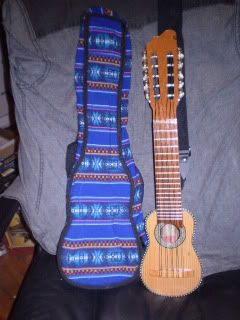Interesting question.
I guess it depends on how you look at it.
I play a load of string instruments: uke, guitar, bass, mandolin, tenor banjo, mandola, bouzouki, fiddle... Experience with each one helps a little with the others.
Which instruments for a uke player to learn? Well, here are a few thoughts.
Mandolin and fiddle - These are small instruments, so would be consistent with the kind of left hand stretches that a soprano or concert 'ukulele player is accustomed to. Tuning is very different though (both are GDAE in ascending 5ths), and fiddle is a pretty alien-feeling thing to players used to strumming and picking. Feels like training to be a contortionist.
Guitar - as the actual intervals of uke strings are the same as on the "top" (highest pitched) strings on a guitar, there are many common chord and scale shapes - although they are transposed. The awkward thing about an acoustic guitar is that it is freakin' ginormous. Honestly, after a year or two of playing 'ukuleles, mandolins and fiddles, a guitar feels like you're trying to strum an ocean liner. I played for 35 years then turned mostly away from guitar. I just picked one up again and it's taking a while to readjust my sense of scale.
Bouzouki - Hmmm... actually, forget it. Even for a veteran guitar player the 'zouk can be a scary exercise in finger stretches. And yet another weird tuning to learn: often GDAD.
5-string banjo - Can also be a bit of a stretch, and means learning a new tuning, but the G drone has some things in common with the rentrant G on an 'ukulele. Clawhammer / frailing style playing works on both instruments. I can see 5-string banjo being an interesting diversion for a uke player.
Once one has mastered the mechanical techniques of fretting, strumming, picking, fingerpicking etc, changing string instruments is largely a matter of learning new chord and scale shapes, and adjusting to different sizes and scale lengths of instruments. Most players rely mostly on "muscle memory" for much of their ability - instinctive playing patterns instilled by repetition. So, in practical terms, when I talk about learning new tunings I mostly mean learning the new pattern shapes associated with those tunings.
Of course, any knowledge of music theory that you may have acquired while learning 'ukulele will apply to any other instrument.
Warnng: learning a heap of instruments can mean that you split your time between so many that you don't get as good at any of them as you might have wished. I have totally overstretched myself and I'm just
sort-of-ok at a bunch of instruments instead of
good at one or two. Trouble is that I love 'em all, and can't give any up.
So approach with caution.

 Does anyone know?
Does anyone know?


